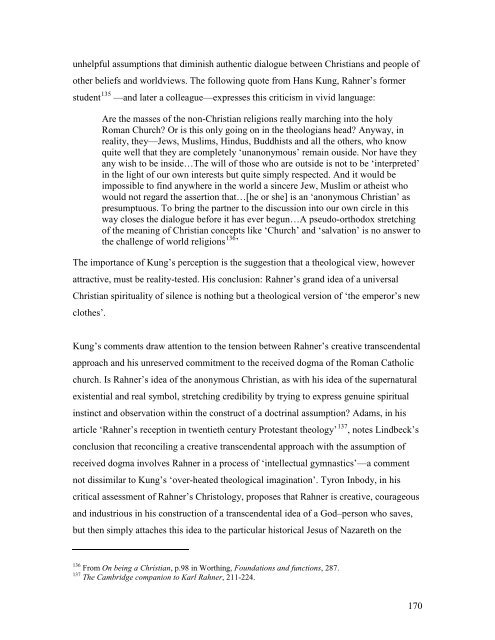Introductory notes for readers of this thesis - Theses - Flinders ...
Introductory notes for readers of this thesis - Theses - Flinders ...
Introductory notes for readers of this thesis - Theses - Flinders ...
Create successful ePaper yourself
Turn your PDF publications into a flip-book with our unique Google optimized e-Paper software.
unhelpful assumptions that diminish authentic dialogue between Christians and people <strong>of</strong>other beliefs and worldviews. The following quote from Hans Kung, Rahner’s <strong>for</strong>merstudent 135 —and later a colleague—expresses <strong>this</strong> criticism in vivid language:Are the masses <strong>of</strong> the non-Christian religions really marching into the holyRoman Church? Or is <strong>this</strong> only going on in the theologians head? Anyway, inreality, they—Jews, Muslims, Hindus, Buddhists and all the others, who knowquite well that they are completely ‘unanonymous’ remain ouside. Nor have theyany wish to be inside…The will <strong>of</strong> those who are outside is not to be ‘interpreted’in the light <strong>of</strong> our own interests but quite simply respected. And it would beimpossible to find anywhere in the world a sincere Jew, Muslim or atheist whowould not regard the assertion that…[he or she] is an ‘anonymous Christian’ aspresumptuous. To bring the partner to the discussion into our own circle in <strong>this</strong>way closes the dialogue be<strong>for</strong>e it has ever begun…A pseudo-orthodox stretching<strong>of</strong> the meaning <strong>of</strong> Christian concepts like ‘Church’ and ‘salvation’ is no answer to136the challenge <strong>of</strong> world religions ’The importance <strong>of</strong> Kung’s perception is the suggestion that a theological view, howeverattractive, must be reality-tested. His conclusion: Rahner’s grand idea <strong>of</strong> a universalChristian spirituality <strong>of</strong> silence is nothing but a theological version <strong>of</strong> ‘the emperor’s newclothes’.Kung’s comments draw attention to the tension between Rahner’s creative transcendentalapproach and his unreserved commitment to the received dogma <strong>of</strong> the Roman Catholicchurch. Is Rahner’s idea <strong>of</strong> the anonymous Christian, as with his idea <strong>of</strong> the supernaturalexistential and real symbol, stretching credibility by trying to express genuine spiritualinstinct and observation within the construct <strong>of</strong> a doctrinal assumption? Adams, in hisarticle ‘Rahner’s reception in twentieth century Protestant theology’ 137 , <strong>notes</strong> Lindbeck’sconclusion that reconciling a creative transcendental approach with the assumption <strong>of</strong>received dogma involves Rahner in a process <strong>of</strong> ‘intellectual gymnastics’—a commentnot dissimilar to Kung’s ‘over-heated theological imagination’. Tyron Inbody, in hiscritical assessment <strong>of</strong> Rahner’s Christology, proposes that Rahner is creative, courageousand industrious in his construction <strong>of</strong> a transcendental idea <strong>of</strong> a God–person who saves,but then simply attaches <strong>this</strong> idea to the particular historical Jesus <strong>of</strong> Nazareth on the136 From On being a Christian, p.98 in Worthing, Foundations and functions, 287.137 The Cambridge companion to Karl Rahner, 211-224.170















